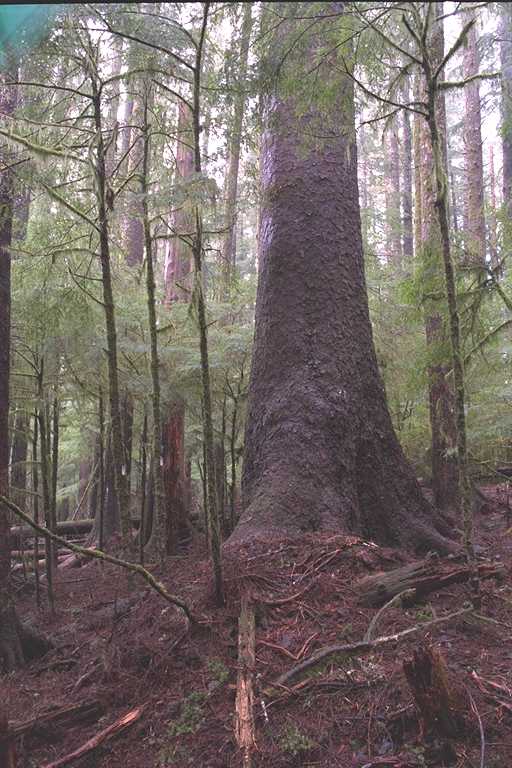|
|
|
|
|
Pringle Falls Experimental Forest, OR
Warm Springs Reservation, OR (photo by Jay Sexton) |
Logs
were sampled at eight different locations in the Western U.S. (Table 1,
Figure 1). The majority (5) of sites were in Oregon, but sites in Washington, Colorado and California
were also examined. A range of climates are represented, with site mean annual temperatures ranging
from 0.5 to 10 C, and total annual precipitation ranging from 737 to 2489
mm year-1 (Figure
2). General
characteristics of each site are described below.
Cascade Head
Experimental Forest (CHEF), Oregon
Fraser Experimental
Forest (FEF), Colorado
Fraser
Experimental Forest is located in the heart of the central Rocky
Mountains, about 50 air miles from Denver.
FEF includes subalpine forests typical of the area, with Engelmann
spruce (Picea engelmannii) and
subalpine fir (Abies lasiocarpa)
predominating at higher elevations and lodgepole pine (Pinus
contorta var. latifolia) predominating at lower elevations and on
drier upper slopes. Soils are
generally derived from gneiss and schist and typically contain angular
gravel and stone with very little silt or clay.
These soils are very permeable and can store considerable water
during snowmelt. Climate
varies strongly with elevation. Overall,
the climate is cool and humid with long, cold winters and short, cool
summers. Mean annual
temperature at the Fraser Forest headquarters is 0.5 C (34 F) and mean annual
precipitation over the entire FEF is 737 mm (29 inches). The
Klamath Ranger District of the Winema National Forest is located in
south-central Oregon, 35 miles northwest of Klamath Falls and south of
Crater Lake National Park.
Elevations on this Ranger District range from 1,277 to 2,430 m
(4,200 feet to 8,000 feet). The
topography is mountainous and dissected. Conifer forests are the dominant
vegetation, and fall within the mixed conifer, white fir (Abies
concolor), Shasta red fir (Abies
magnifica), and mountain hemlock (Tsuga
mertensiana) zones of Franklin and Dyrness (1973).
Mixtures of white fir, ponderosa pine (Pinus ponderosa), and Douglas-fir occur at the lowest elevations and
red fir, mountain hemlock, western white pine (Pinus monticola) and lodgepole pine occur at the highest elevations
(Hopkins 1979). Soils are
generally well-drained, gravelly and cobbly fine sandy loams to loam, with
10-75% coarse fragments (Carlson 1979).
The climate is characterized by cold, snowy winters and warm, dry
summers (Carlson 1979).
The mean annual temperature is 4.4 C (40 F).
Mean annual precipitation is 1054 mm (41.5 inches). Pringle
Falls Experimental Forest is located in central Oregon, about 6 miles west
of La Pine, within the Deschutes National Forest.
The forests are characteristic of low elevation forests within the
High Cascades physiographic province and are comprised of ponderosa pine,
lodgepole pine, and higher elevation mixed conifer.
Soils are derived from aerially deposited Mount Mazama pumice and
ash with only a thin weathered surface layer.
Most of the soil profile is undeveloped, with low organic matter
content and high porosity. The
climate at PFEF is continental, and most precipitation occurs as snowfall.
Annual precipitation averages 813 mm (32 inches) and the average
temperature is 7 C (45 F). Sequoia National Park (SQNP),
California Sequoia
National Park is located in the Sierra Nevada mountain range of
East-Central California within Tulare and Fresno Counties.
The sample plots for this study were located in the Giant Forest
region of the park. Vegetation
in this region is typical for midelevation mixed conifer forests in the
Sierra Nevada (Rundel et al. 1977). The
forests of this area are dominated by white fir, red fir (Abies
magnifica), incense cedar (Calocedrus
decurrens), sugar pine (Pinus
lambertiana), Jeffrey pine (Pinus jeffreyi), and giant sequoia (Sequoiadendron
giganteum) (van
Mantgem et al. 2003). Soils
are primarily Pachic Xerumbrepts, derived from granodiorite (Huntington
and Akeson 1987). The climate
of this area is Mediterranean, with wet, snowy winters and long, dry
summers. The mean annual
precipitation is 1255 mm (49 inches), with approximately half occurring as
snow. The mean annual
temperature is 8 C (46 F). Warm
Springs Reservation (WSR), Oregon. The
Warm Springs reservation plots are located in north central Oregon,
approximately 8 miles from the town of Government Camp and bordering the
Mt. Hood National Forest.
The forests are characteristic of mid to high elevation forests
within the High Cascades physiographic province and are comprised of
Douglas-fir, western hemlock, noble fir, pacific silver fir, and higher
elevation mixed conifer.
The climate is characterized by cold, snowy winters and warm, dry
summers. The
mean annual temperature is 8.3 C (47 F).
Mean annual precipitation is 1778 mm (70 inches). Wind
River Experimental Forest (WREF), Washington. The Wind River Experimental
Forest is near Carson, Washington in the Gifford Pinchott National Forest. The forest is classified as a western hemlock/salal (Gaultheria
shallon) cover type, and is estimated to be ~500 years old.
Dominant tree species are Douglas-fir and western hemlock.
Dominant understory shrub species are vine maple (Acer
circinatum),
salal, and dwarf Oregon grape (Berberis nervosa).
Soils are of the Stabler series, coarse textured and developed on 2
to 3 meters of volcanic ejecta over basalt bedrock.
Texture ranges from shotty loam to clay with coarse particles in
the top 1 m averaging 3% of the soil volume.
The climate is characteristic of a temperate winter-wet, summer-dry
climate. Annual precipitation totals 2467 mm with less than 10% occurring
between June and September. Mean
annual temperature is 8.7°C.
|

